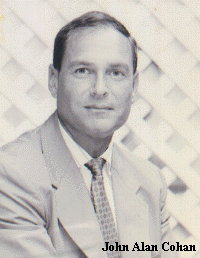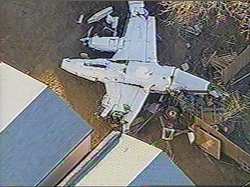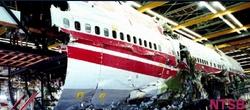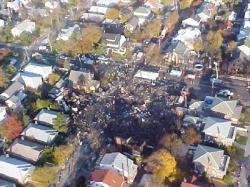By ANN Columnist John Alan Cohan, Attorney at Law
 There is still no clear answer as to what caused
the midair collision between two private airplanes over northwest
Denver on January 24, 2003. Both aircraft were destroyed by impact
forces and fire, and five people were killed in the crash. Both
pilots requested and received a service known as visual flight
rules (VFR) flight following. One pilot, in a Piper Cheyenne,
reported to Air Traffic Control that his altitude was 7,600 feet.
The controller who was providing basic radar services to both
pilots then issued a traffic advisory to the pilot, indicating that
there was a Cessna at his twelve o’clock position and l mile,
at 7,700 feet. The accident occurred shortly thereafter. There were
broken and scattered clouds from 6,000 feet to l4,000 feet.
Additionally, the sun had set about 20 minutes before the
accident.
There is still no clear answer as to what caused
the midair collision between two private airplanes over northwest
Denver on January 24, 2003. Both aircraft were destroyed by impact
forces and fire, and five people were killed in the crash. Both
pilots requested and received a service known as visual flight
rules (VFR) flight following. One pilot, in a Piper Cheyenne,
reported to Air Traffic Control that his altitude was 7,600 feet.
The controller who was providing basic radar services to both
pilots then issued a traffic advisory to the pilot, indicating that
there was a Cessna at his twelve o’clock position and l mile,
at 7,700 feet. The accident occurred shortly thereafter. There were
broken and scattered clouds from 6,000 feet to l4,000 feet.
Additionally, the sun had set about 20 minutes before the
accident.
A frequent cause of airplane accidents involves spatial
disorientation resulting from the pilot’s failure to maintain
positive manual control of the airplane with the available flight
instrumentation.
The National Transportation Safety Board ("NTSB") was
established in l967 is an independent Federal agency "to promote
transportation safety by conducting independent accident
investigations and by formulating safety improvement
recommendations" (Public Law 93-633). The NTSB has broad
jurisdiction to inspect aviation, marine, railroad, pipeline and
highway accidents. It is not part of the Department of
Transportation, nor organizationally affiliated with the Federal
Aviation Administration.
 The NTSB investigates about 2,000 aviation
accidents and incidents a year, and about 500 accidents in the
other modes of transportation--rail, highway, marine and pipeline.
They have 400 employees. Whenever an aviation accident occurs, NTSB
investigators go to the accident scene as quickly as possible. They
carry with them tools such as wrenches, screwdrivers, flashlights,
tape recorders, cameras, and other equipment. They document the
airframe wreckage and the accident scene, including calculation of
impact angles to help determine the plane’s pre-impact course
and altitude. They examine the engines, propellers and engine
accessories. They make a study of the components of the
plane’s hydraulic, electrical, pneumatic and associated
systems, together with instruments and elements of the flight
control system.
The NTSB investigates about 2,000 aviation
accidents and incidents a year, and about 500 accidents in the
other modes of transportation--rail, highway, marine and pipeline.
They have 400 employees. Whenever an aviation accident occurs, NTSB
investigators go to the accident scene as quickly as possible. They
carry with them tools such as wrenches, screwdrivers, flashlights,
tape recorders, cameras, and other equipment. They document the
airframe wreckage and the accident scene, including calculation of
impact angles to help determine the plane’s pre-impact course
and altitude. They examine the engines, propellers and engine
accessories. They make a study of the components of the
plane’s hydraulic, electrical, pneumatic and associated
systems, together with instruments and elements of the flight
control system.
NTSB investigators reconstruct the air traffic services given
the plane, including acquisition of ATC radar data and transcripts
of controller-pilot radio transmissions. They gather all pertinent
weather data from the National Weather Service, and sometimes from
local TV stations, for a broad area around the accident scene. They
investigate crew performance and all before-accident factors that
might be involved in human error, including fatigue, medication,
alcohol, drugs, medical histories, training, workload, equipment
design and work environment.
 They may impound the airplane and send the engine
to a manufacturer or overhaul facility, the systems to an
instrument manufacturer’s plant, and so on. They may make
safety recommendations at any time during the course of an
investigation.
They may impound the airplane and send the engine
to a manufacturer or overhaul facility, the systems to an
instrument manufacturer’s plant, and so on. They may make
safety recommendations at any time during the course of an
investigation.
If there is evidence of criminal wrongdoing the NTSB will bring
in the FBI. An example of this was the crash of Pacific Southwest
Airlines in San Luis Obispo, California, on December 7, l987. All
43 persons aboard died in the crash. Because of information
conveyed over the radio by the flight crew
shortly before the crash, the FBI instituted an investigation
parallel to the Safety Board’s investigation, to determine if
a crime had been committed. They learned that a former employee of
the airline had boarded the plane with a gun and, while the plane
was in cruise flight, shot the flight crew, causing the aircraft to
crash.
 Safety recommendations are the most important part
of the Safety Board’s mandate. They must address safety
deficiencies immediately, and therefore often issue recommendations
before the completion of investigations. Recommendations are based
on findings of the investigation, and may address deficiencies that
do not pertain directly to what is ultimately determined to be the
cause of the accident. The NTSB was asked to assist NASA in the
investigation of the recent loss of the space shuttle
"Columbia."
Safety recommendations are the most important part
of the Safety Board’s mandate. They must address safety
deficiencies immediately, and therefore often issue recommendations
before the completion of investigations. Recommendations are based
on findings of the investigation, and may address deficiencies that
do not pertain directly to what is ultimately determined to be the
cause of the accident. The NTSB was asked to assist NASA in the
investigation of the recent loss of the space shuttle
"Columbia."
For example, in the course of its investigation of the crash
landing of a DC-10 in Sioux City, Iowa, in l989, the Board issued
recommendations on four separate occasions before issuance of its
final report. In the case of the crash of an ATR-72 in Roselawn,
Indiana, in l994, the Board issued urgent safety recommendations
within one week of the accident.
 Some companies and institutions that own and
operate aircraft, or which charter aircraft, may not be providing
adequate oversight for travel policies pertaining to the safe
operation of company aircraft. A model travel policy should provide
that inspection and maintenance must be performed by an
appropriately rated FAA-certified repair station, the manufacturer,
or a manufacturer-authorized service center. Maintenance personnel
must be appropriately rated and have been trained within the
previous 5 years to maintain the aircraft type to be used. Model
policy should also require that the aircraft be certified for
flight into known icing conditions. Policy should also advise that
passengers cannot enter the cockpit or distract the pilots when an
aircraft is below 10,000 feet on takeoff or landing operations. A
cautious and prudent policy should also indicate that all flights
are to be operated on an IFR flight plan and that aircraft may not
depart into forecast hazardous weather conditions, including severe
icing, thunderstorms, or severe turbulence or windshear.
Some companies and institutions that own and
operate aircraft, or which charter aircraft, may not be providing
adequate oversight for travel policies pertaining to the safe
operation of company aircraft. A model travel policy should provide
that inspection and maintenance must be performed by an
appropriately rated FAA-certified repair station, the manufacturer,
or a manufacturer-authorized service center. Maintenance personnel
must be appropriately rated and have been trained within the
previous 5 years to maintain the aircraft type to be used. Model
policy should also require that the aircraft be certified for
flight into known icing conditions. Policy should also advise that
passengers cannot enter the cockpit or distract the pilots when an
aircraft is below 10,000 feet on takeoff or landing operations. A
cautious and prudent policy should also indicate that all flights
are to be operated on an IFR flight plan and that aircraft may not
depart into forecast hazardous weather conditions, including severe
icing, thunderstorms, or severe turbulence or windshear.
FMI: John Alan Cohan is a lawyer based in Los Angeles
specializing in tax and aviation law. He can be reached by e-mail
at johnalancohan@aol.com
 ANN's Daily Aero-Linx (04.16.24)
ANN's Daily Aero-Linx (04.16.24) Aero-News: Quote of the Day (04.16.24)
Aero-News: Quote of the Day (04.16.24) Airborne 04.10.24: SnF24!, A50 Heritage Reveal, HeliCycle!, Montaer MC-01
Airborne 04.10.24: SnF24!, A50 Heritage Reveal, HeliCycle!, Montaer MC-01 Airborne 04.12.24: SnF24!, G100UL Is Here, Holy Micro, Plane Tags
Airborne 04.12.24: SnF24!, G100UL Is Here, Holy Micro, Plane Tags Airborne-Flight Training 04.17.24: Feds Need Controllers, Spirit Delay, Redbird
Airborne-Flight Training 04.17.24: Feds Need Controllers, Spirit Delay, Redbird







